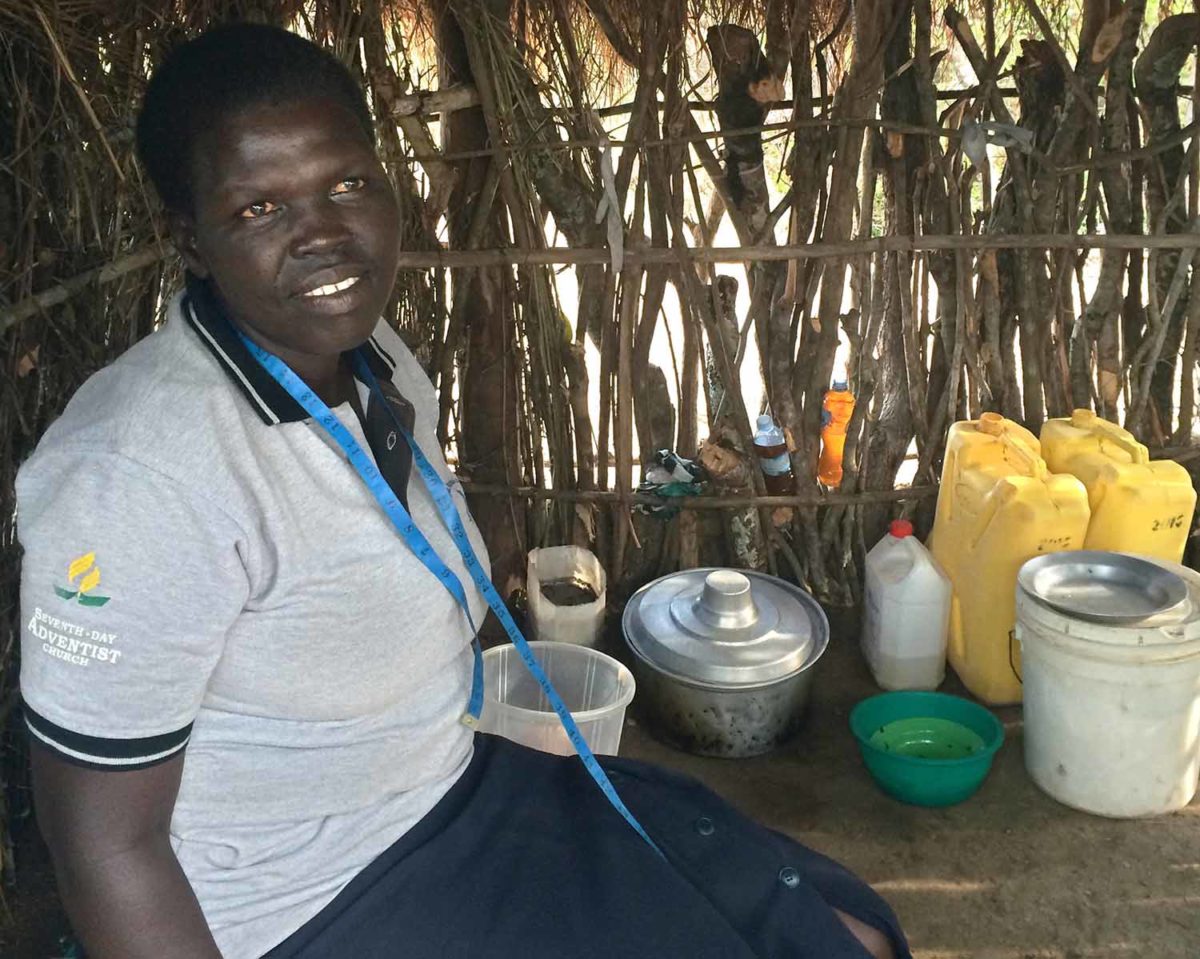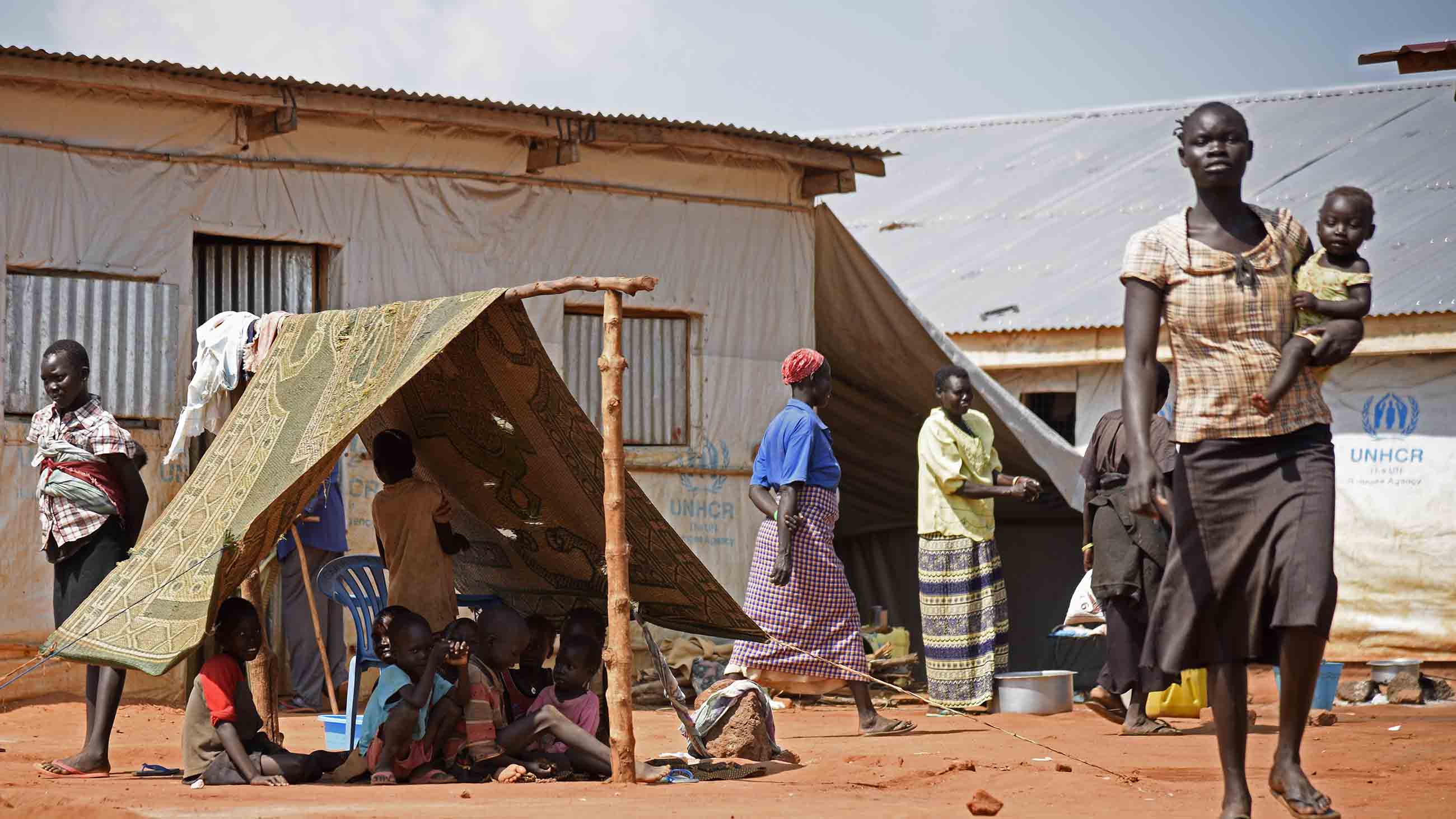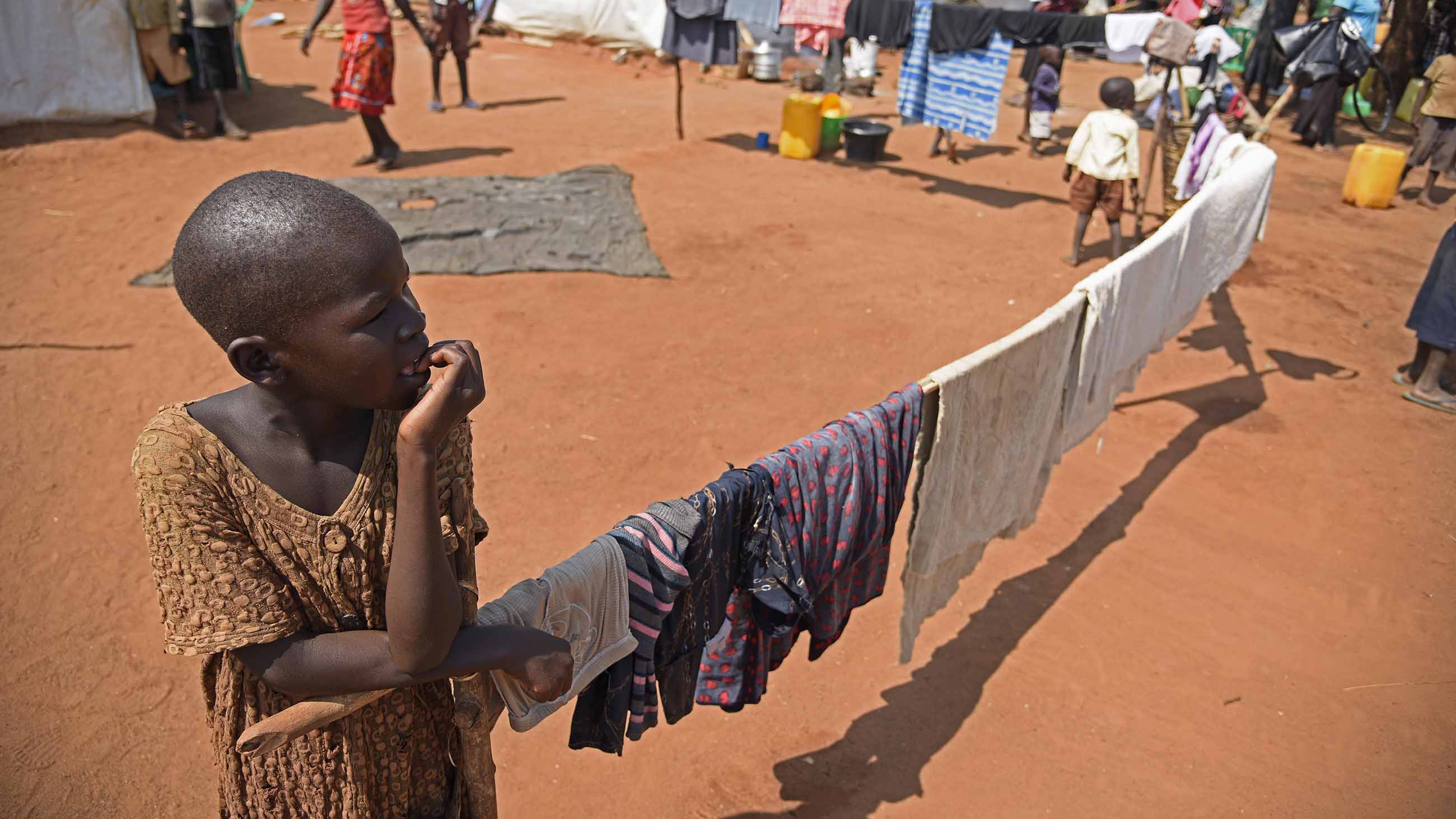Far From Being a Burden, Research Suggests Refugees Come With Benefits
When war hit close to home, Veronica Mesiko Simon grabbed a few dishes and a bundle of clothes. With a load on her head, six kids and a mother in tow, she ran for the Ugandan border, six miles away from her home in South Sudan. And just like that, everything changed. Simon and her family became refugees.
They spent a month last summer in a transit center before transferring to a settlement called Pagirinya, where Simon and her kids built a makeshift house of tarps and wood. When I met her in September, she told me she was determined to make this new life work, to get her kids in school, “even if I sleep on an empty stomach.” Refugee life would be hard, she said, but better than war. Uganda offered freedom from the crisis in South Sudan, where peace talks between government and opposition forces collapsed, and attacks against civilians that began last July have escalated ever since.
Standing on the packed Ugandan earth of her new home, Simon said, “I am waiting to bear however hard the condition may be.”

Veronica Mesiko Simon sits in the kitchen she built by hand. “I am waiting to bear however hard the condition may be,” she says.
Visual: Karen J. Coates
More than 1.5 million South Sudanese carry the baggage-laden label “refugee.” By the end of 2015, conflict and persecution had forcibly displaced 65.3 million people from their homes worldwide — more than at any other time since the United Nations started counting. More than 21 million of those were refugees who had crossed international borders. Anytime a man, woman, or child seeks asylum or refuge in another country, the upheaval becomes one of political and financial concern.
Refugees need food, clothes, shelter, and health care. Their kids need education, and sometimes counseling. Processing the necessary paperwork takes time and money, all of it at government expense. The common assumption is that refugees burden the economy of the country that takes them in. (President Trump and company have made great political capital of this notion.)
But such public perceptions are often based on anecdotes and preconceived notions, not science or data. New evidence suggests that the assumption that refugees burden their hosts is simplistic and usually wrong.
At least a dozen local, regional, and global analyses published in the last five years provide credible evidence that refugees and migrants offer long-term economic benefits for their new communities. J. Edward Taylor, a professor of agricultural and resource economics at the University of California, Davis, and director of the Rural Economies of the Americas and Pacific Rim Program, led two such studies, from Rwanda and Uganda, finding that every dollar spent by governments and organizations on refugee aid is multiplied as added income.
This “spillover,” as economists call it, accrues when refugees buy goods and services from local vendors and producers. In Rwanda, each additional refugee resulted in an added $205 to $253 to the economy each year. In Uganda, each refugee dollar spent generated an additional $1 to $1.50 in local income. Spillover benefits are higher when refugees receive cash transfers instead of food aid. In fact, the World Food Program promotes a program doing just this in part because it also allows refugees to make their own market choices.
Taylor and his team — from UC Davis, the International Food Policy Research Institute, and the World Food Program — conducted elaborate surveys of households and businesses in and around refugee settlements to construct economic models of refugee households, local households and markets. “The results show clearly that refugees benefit those countries that welcome them and give them what they need to build new lives,” according to Cheryl Harrison, the World Food Program’s deputy country director in Uganda.
Taylor said he had never studied the economic effects of refugees in host countries, and “I didn’t know what we would find.” But the results signaled something “really big — here we are in a time when we think of refugees as being only a cost. And in real life, refugees can create these benefits.”
There is a trendiness to this research — and for good reason, as some refugee crises have reached what the U.N. calls a “breaking point.” Despite Uganda’s successes in accommodating refugees, on March 23 the country’s government and the U.N. High Commissioner for Refugees issued a plea to the international community asking for additional support: More than 800,000 South Sudanese have fled to the country, and “Uganda cannot handle Africa’s largest refugee crisis alone,” Commissioner Filippo Grandi said in a statement.
This and other forced migrations show no sign of letting up. So as one Oxford study notes, a better understanding of refugee economic systems “may hold the key to rethinking our entire approach to refugee assistance.”
It’s hard to generalize because every scenario is different, said Roger Zetter, emeritus professor and former director of the Refugee Studies Center at the University of Oxford. How many people are coming? How quickly? And how healthy is the local economy? “A million refugees in Germany is quite a problem; a million refugees in Lebanon is a catastrophe,” he said, because the economy can’t cope.
A sudden population influx is often “a significant stress factor,” especially in cities where overcrowding, lack of sanitation, insecurity, violence and poor health are already problems, according to the Overseas Development Institute, an independent London-based think tank on international development and humanitarian issues. But an ODI report published in January finds that new arrivals can boost the local economy, trade and entrepreneurship of urban areas in the long term.
That’s the predominant message in an expanding pool of data. An Open Political Economy Network study released last May determined that an investment in “welcoming refugees” will nearly double in economic benefits within five years. Refugees often take “4D” jobs — dirty, difficult, dangerous or dull — that many don’t want. They start new businesses that create new jobs. The experience of being uprooted from one culture and exposed to another often sparks creativity and entrepreneurship among refugees. And they tend to be young, with a lifetime to work.
The report points to Vietnamese refugees in the 1970s and 1980s who arrived in foreign countries to much disdain and dismay. “Yet refugees from Vietnam now have a higher employment rate and greater average incomes than people born in the U.S.,” according to the report. Furthermore, “policymakers and practitioners should stop considering refugees as a ‘burden’ to be shared, but rather as an opportunity to be welcomed.”

When refugees and voluntary migrants are studied together, the message is similar. A study from the National Academies of Sciences, Engineering and Medicine published in September found that immigration is “integral to the nation’s economic growth.” The report, covering 20 years of data, included a few caveats — first-generation immigrants are initially expensive, the economic effects of immigrants vary widely across states, and the effects are often negative at the local level. But the children of immigrants “are among the strongest economic and fiscal contributors in the U.S. population, contributing more in taxes than either their parents or the rest of the native-born population.”
A McKinsey Global Institute report on forced and voluntary migration around the world found that migrants added roughly $6.7 trillion to the global economy in 2015 — 9.4 percent of the worldwide GDP, and $3 trillion more than those migrants would have produced if they had stayed at home. This is largely because migrants tend to move to more productive regions with more developed economies. And contrary to popular rhetoric, “migrants do not harm the long-run employment or wages of native workers,” the study notes.
The McKinsey authors have a clear recommendation for policymakers: “Change the narrative.” Think of immigration as “an opportunity to gain long-term dividends despite short-term challenges.”
Richard Parsons, who assesses social impacts for the New South Wales government in Australia, agrees. In 2013, he reviewed dozens of reports on the economic impact of refugees across nations for the Multicultural Development Association. “No study found refugees to present an economic burden over the long term,” he said.
What he did find were variations in methods and analyses. “Economic impact” can have a narrow meaning — taxes, social security — or a broad definition that includes social capital, unpaid work or remittances sent to families back home. And while the economic effects of refugees play out over generations, policies and public opinion are often shaped by short-term consequences. Further, many studies lump refugees and voluntary migrants into the same pool, but the two groups can present disparate socioeconomic scenarios. Immigrants often arrive prepared, with a plan for work and settlement; refugees often arrive with few possessions, few plans, but many needs.
But the overall finding offered a powerful message, Parsons said: “It implies that we have nothing to fear from accepting refugees, as long as appropriate mechanisms and support programs are in place to help people resettle and integrate.”
Zetter, at Oxford, agrees that countries should incorporate refugees into long-term national development strategies. “A lot of the evidence shows that refugees can be a positive resource…,” he said, but added “the fact of the matter is that most countries do not want to encourage settlement of refugees.”
Uganda is one place that does. Here, refugees and locals “are living in harmony,” and it’s nothing new, a Ugandan village council leader named Dramoyo Henry explained to me. The people of northern Uganda and South Sudan have crossed the border many times over many decades, through multiple wars. In the 1980s, Ugandans fled conflict at home, settling as refugees in South Sudan. In 1991, the tables turned, and thousands of South Sudanese moved south. That was the first time Henry’s community offered refugees some of their farm fields and grazing plots for settlements. Tens of thousands came, and most stayed until 2006, when peace and repatriation deals were signed. Now, with renewed fighting and a new influx of South Sudanese, Henry said, “the decision was unanimous.” His community offered its land to refugees — again.
When I met with Simon at her settlement home, she told me she didn’t arrive in Uganda with much — but she did have a plan. She built herself a new kitchen from freshly cut branches and grass. She planted a small garden of pumpkins and peas, and patiently awaited the rain. One day, she told me, she hoped to grow enough food to supplement the aid she receives from the World Food Program. And she would work as a tailor, just as she did in South Sudan, sewing bright, patterned dresses in primary colors.
Simon kept a bulging sack of cloth outside her home, advertising her services to the neighbors who passed on foot throughout the day. Pagirinya was just getting settled, and few residents had money to spare. But she hoped some would purchase enough dresses so she could — eventually — buy more cloth and sell more clothes. She had a mother and six kids to feed. “I have brought them here to hide them from persecution,” she said. “If I take them back, their life can be taken.”
Like many, Simon spoke more of her children than herself. The future depends on the young generation, she said. And the young generation depends on what their parents do now. That’s a big incentive for Simon to work hard and prosper in Uganda. “These are the future leaders,” she said.
Karen Coates is a senior fellow at Brandeis University’s Schuster Institute for Investigative Journalism, and a fellow with the International Women’s Media Foundation. Her article “Bombscapes,” about the enduring effects of U.S. bombing in Southeast Asia, appeared in Undark in September.
An International Women’s Media Foundation fellowship supported the reporting for this story.











Comments are automatically closed one year after article publication. Archived comments are below.
Marvelous propaganda piece;asusual.Who’s sponsoring this site?
That a cruel and strange self-inflicted punishment the European countries have decided to inflict on their citizens, especially Women, for their crimes in Africa during 17-20th centuries. Rape, murder.. the “refugees” are not, and will not assimilating.
Worse, they are taking the best people out of Africa. Who will rebuild it? who is left? Women and children?
Will Europe ever talk the current slavery situation in Africa? no. They couldn’t protect 1400 girls in Rotherham , just one city in Britain, because they were too afraid to talk.
Europe is doomed. The refugees are taking over nothing. Who will operate this continent in 30, 50 years? Do they understand how to survive in a continent so dependent on technology?